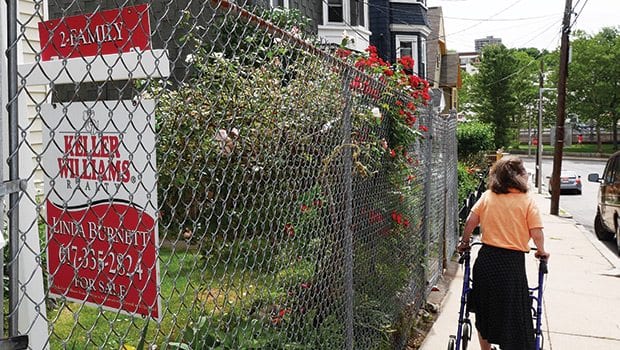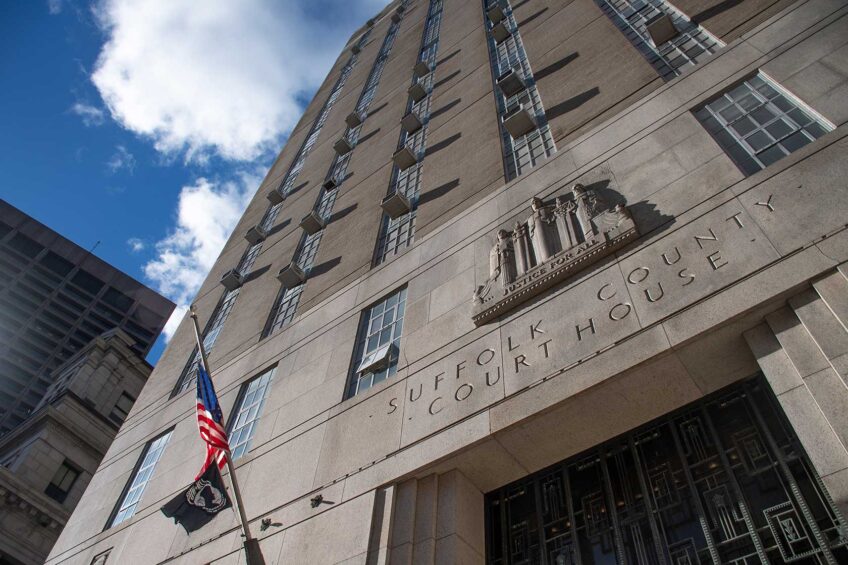Elders feel effects of housing prices
Some safe, others vulnerable as gentrification progresses

The elder experience of gentrification
Part 2 of a 2-part series Read Part 1 in the series here.
Boston’s South End is cited nationwide as a textbook example of gentrification already out of the gate, and the city’s Chinatown neighborhood is struggling for its very Chinese-ness as luxury towers proliferate all around it. In other Boston neighborhoods, residents and policymakers grapple with various stages of transformation, harboring hope there’s still time to slow things down, or at least mitigate the displacement of lower-income workers, families and seniors.
For older residents in Jamaica Plain and Roxbury, experiences and feelings vary as housing prices rise and their neighborhoods change around them. Some are vulnerable to displacement, while others have found stable, affordable housing. Longtime homeowners have the luxury of contemplating whether to sell, some happy for the significant financial opportunity but hesitant to push a neighborhood shift that often results in fewer people of color.
Million-dollar JP condos
Navigating Jamaica Plain’s Chestnut Avenue area with her walker, longtime affordable housing advocate Betsaida Gutierrez noted that nearby Forbes Street is where she lived with relatives when she arrived from Puerto Rico in 1972. This street and some other nearby streets were once mainly Latino families and still have some longtime Latino-owned homes, but closer to Stony Brook T station, many have been converted to condos and sold to a whiter and more affluent population.
Gutierrez, in her 60s and recently disabled by illness, has been lucky to land in an accessible, affordable apartment in a JP Scattered Sites cooperative building built by Jamaica Plain Neighborhood Development Corporation. It’s a happy ending to a harsh story, as her move was forced. She was given 30 days to leave another Jamaica Plain apartment in which she had lived 15 years, she explained, when her previous landlord wanted to use the unit.
“We have worked real hard in this neighborhood to make it change, and all we are seeing is displacement,” said Gutierrez, who has worked for decades on behalf of JP’s Latino community.
She pointed out several starkly modern, slate-gray buildings that hold million-dollar condos. These luxury buildings are interspersed with older houses, some carefully refurbished and others visibly deteriorated. Showing a reporter the neighborhood on a June day, Gutierrez was surprised to find a new For Sale sign on a Latino-owned older single-family home, in addition to the condos for sale she notices every day.
“When a house gets sold, it usually turns into condos,” she said. “Gentrification is here, and I don’t know when it’s going to change.”
Opportunity kicks down the door in Roxbury
In Roxbury, change has lagged behind other neighborhoods, but residents and advocates now are feeling the pressure of sharply rising prices, a shift from a majority-black community to one that has growing proportions of both white and Latino residents, and growing encroachment by college student tenants.
“It’s unbelievable how quickly prices have started to rise. It’s almost perpendicular,” said Roxbury-based real estate broker Sharif Abdal-Khallaq. He noted that a single-family home recently sold for more than $600,000, a price unheard of in the area just a few years ago.
“Now you’re beginning to see many, many more white people here,” he said. “[But] gentrification doesn’t mean race — it’s just the vast contrast in incomes. It can look like race, but it’s actually more about income and salary, and the wherewithal to afford the property.”
For elders, said Abdal-Khallaq, who describes himself as of a “seasoned” age, home ownership became difficult over time with rising taxes and repair costs. He understands the desire to cash out their hard-won investment.
“It’s very expensive [to stay]. I think this is the time for them to take advantage of the situation, if they’re suffering and struggling to hang onto a property without getting help from their kids,” he said. “For me, it just makes sense to let it go and enjoy your elder years.”
Abdal-Khallaq, personally invested in Roxbury as a longtime resident, owner of a family business, a landlord and a broker, takes a philosophical but pragmatic view of the changes he sees and feels.
“We brought a lot of good people into this neighborhood and made a good place for our children and grandchildren. But now the second and third generation is not following suit. And people from other neighborhoods are leaving theirs and coming here,” he said. “It’s almost a natural progression.”
Still, he has concerns. In his own past, he said, he considered a more suburban location but chose a city neighborhood where he wouldn’t have to “deal with the indignations that people of color face.”
Now, as Roxbury changes, he wants to make sure an influx of newcomers doesn’t make it less welcoming for old-timers.
“As long as the people who come respect me, I’m fine with whoever it is. But how will I be treated as I age myself?” he asked.
Dudley land trust adds stability
Diane Dujon, 68, remembers when no one wanted to live in Roxbury’s Dudley Triangle.
“I was living in Mattapan, and I’d go visit my friend in this area, and it was terrible — a lot of abandoned houses, open land,” she said.
Now she can scarcely believe current Roxbury apartment prices.

Author: Sandra LarsonJamaica Plain resident and housing activist Betsaida Gutierrez on her front porch.
“When I go down the street, and I see how much they’re charging, I think, Who can afford it? So people who live here are being forced to leave.”
Dujon feels blessed that 17 years ago she had an opportunity through a lottery to buy a home in Dudley Street Neighborhood Initiative’s community land trust. Now, her housing is secure as she watches the area change.
Diversity endures in the land trust, she observed, even as it fades away in other parts of the city.
“Directly across the street from me, people are Haitian; next to them Asian; next to them Cape Verdean,” said Dujon, who is African American, speaking by phone from her front porch. “I love it. Because DSNI has kept it affordable, people from different backgrounds can live here. Every day I thank God for this place.”
Her situation is secure, but she is concerned about other residents.
“All these years when nobody wanted to live in this neighborhood, the people who lived here were struggling,” she said. “Now everyone wants to live in the city, and the people who struggled to fix it up have to leave.”
“I think I’m safe for a while”
About a half-mile away from Dujon’s house, 65-year-old retiree Ms. Bessie rents a Roxbury apartment from a private landlord. Her rent has gone up a few times in her 20-plus years there, but it’s been more or less stable, though she has no lease, just a month-to-month tenant-at-will agreement.
“I think I’m safe for a while. My landlord, he’s a good guy,” she said.
But she knows things could change.
“Right now it’s affordable. But if he sells, then I’m sure that it won’t be. It’ll go sky high,” she said. Across the street, she noted, an apartment is priced at $2,700.
“All the streets around here are changing. It’s like an overnight thing. And it’s all about money,” she said.
Ms. Bessie doesn’t know what she’ll do if she has to leave her apartment.
“I have no idea. I’m going to stay put until something happens.” She has applied for a Section 8 voucher, but expects a long wait for it.
“But what are you going to do?” she asked rhetorically. “I don’t want to move to Randolph or Brockton. I’ve been here in Roxbury most of my life.”
A new housing plan, but is it enough?
Mayor Martin Walsh’s administration is well aware of Boston’s pressing need for affordable and senior-targeted housing.
“The market is producing high end units all around us, but the communities were built by seniors, low-income residents and middle-class workforce people,” Walsh said at last October’s unveiling of his sweeping new housing plan. “We have to make sure that as we grow, we protect and enhance the diversity that makes Boston a great city.”
Seniors are Boston’s fastest-growing demographic segment. Walsh’s housing plan calls for 5,000 new units of senior housing by 2030, with 1,500 of them designated affordable, and discusses possible approaches to mitigating displacement in gentrifying neighborhoods.
So far this year, no new senior units have been completed, though 284 have been permitted, according to a quarterly housing plan update the city issued in May.
The city’s actions on senior housing will be watched closely by advocates like Davida Andelman, a 69-year-old retired public health professional and Dorchester native who has been working to increase senior housing in the Bowdoin-Geneva neighborhood. Wait lists are long for senior-designated public housing and other subsidized options, Andelman said, and much of the housing developers or officials may deem affordable is not really so.
“They say ‘middle income,’ but middle income folks around here can’t pay $2,300 or $2,500 rents, or buy $450,000 condos,” she said in a phone interview.
Among area seniors, she said, she sees a lot of doubling and tripling up to remain housed.
“We need to think about people aging in place in an area they are comfortable, an area they chose to live,” she said. “The bottom line is that the older folks get, their incomes more often than not go down. They ought to be taken care of, and respected for their contributions to society.”
Andelman and noted that while people are living longer, crucial federal funding for senior housing has dried up, and state funding is down as well. The need for creative solutions is increasingly urgent.
“Public policy needs to catch up with the times,” said Andelman. “We need to think these things out. Time is moving on, and we’re not getting younger.”
Sandra Larson wrote this article through a Journalists in Aging Fellowship, a collaboration of New America Media and the Gerontological Society of America, with support from AARP. This story is part of a series on housing challenges for low-income seniors. Previous segments covered the challenges for elder homeowners of keeping up with repairs, and elder vulnerability to predatory lending schemes.






